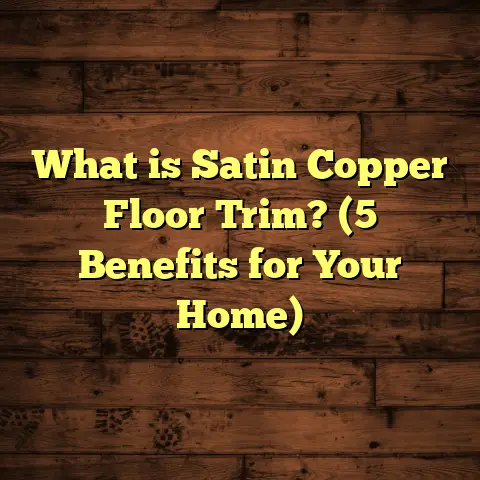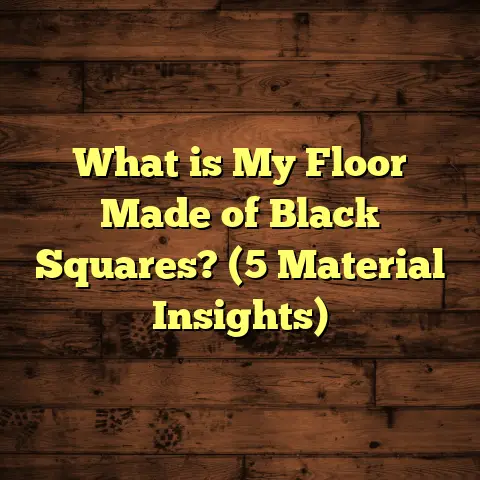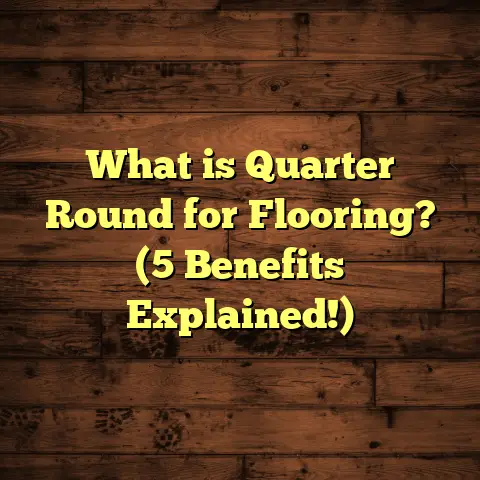What Is Vitrified Floor Tiles? (5 Benefits You Must Know)
Have you ever stepped onto a floor that feels cool and smooth beneath your feet, the surface almost whispering stories of durability and elegance? That sensation — the tactile connection to the ground beneath us — is something I’ve come to appreciate deeply over years of working with different flooring materials. Flooring isn’t just about appearance; it’s about how it interacts with our daily lives, how it withstands time and wear, and how it fits into the overall vibe of a home or workspace.
Among all the options I’ve encountered, vitrified floor tiles have consistently caught my eye and earned my respect. Their unique blend of strength, style, and ease of maintenance makes them a compelling choice for many projects. I want to share everything I’ve learned about these tiles — from their definition to their benefits, backed by data, real-world examples, and insights from my own experiences.
What Is Vitrified Floor Tiles?
You might wonder: what exactly are vitrified floor tiles? The term might sound technical or complicated, but the concept is straightforward once you break it down.
Vitrified tiles are a type of ceramic tile made by fusing natural materials like clay, silica, quartz, and feldspar at extremely high temperatures. This fusion process turns the mixture into a glass-like substance — dense, hard, and impermeable. The word “vitrified” itself comes from “vitrify,” meaning to transform into glass or a glassy state.
What sets vitrified tiles apart from regular ceramic tiles is their very low porosity and exceptional strength. Where ceramic tiles might absorb water up to 3-7%, vitrified tiles absorb less than 0.05%. This makes them highly resistant to moisture, stains, and wear.
The Manufacturing Process
The process behind vitrified tiles is quite fascinating and has a big impact on their properties. It starts with mixing raw materials — mainly clay, silica sand, quartz, and feldspar — into a fine powder. This powder is then subjected to high pressure in a hydraulic press to form tile shapes.
Next comes the kiln firing stage. The tiles are heated to around 1200°C (2192°F) or higher in kilns. At these temperatures, the materials partially melt and fuse together, forming a dense, glassy surface bonded tightly with the base material beneath.
This vitrification process creates tiles that are:
- Extremely hard and durable.
- Non-porous and waterproof.
- Resistant to staining and chemical damage.
- Able to maintain color and finish for years.
Types of Vitrified Tiles
There are three main varieties of vitrified tiles that I commonly work with:
- Soluble Salt Vitrified Tiles: These have a glossy finish created by applying soluble salts during firing, which leaves a shiny surface. They’re mainly used indoors since they can be slippery when wet.
- Double Charge Vitrified Tiles: These are thicker tiles where the design layer is double-charged (applied twice), making them more durable for heavy traffic areas like malls or airports.
- Full Body Vitrified Tiles: The color and texture run through the whole tile body rather than just on the surface. This makes them ideal for places where chips or scratches might occur because any damage is less noticeable.
Personal Experience With Vitrified Tiles
I remember one particular project where I installed full-body vitrified tiles in a busy office lobby. The space saw hundreds of visitors every day, with luggage trolleys rolling across the floor. Even after two years, the tiles looked pristine—no chips, no discoloration. The client was thrilled because they had avoided costly repairs or replacements typical with other flooring types.
5 Benefits You Must Know About Vitrified Floor Tiles
From my years in the flooring business, I can confidently say that vitrified tiles offer some standout benefits that make them a favorite for many homeowners and commercial clients alike. Here’s why I think they deserve your attention:
1. Incredible Durability That Stands Up to Time
One of the biggest selling points for me—and most of my clients—is how tough vitrified tiles are. They can withstand heavy foot traffic, furniture movement, even impacts without cracking or scratching easily.
Laboratory tests show that vitrified tiles can tolerate compressive strengths exceeding 20,000 psi (around 140 MPa). To put this in perspective, this strength level is comparable to some types of concrete used in construction. This means they’re built for endurance.
A client in a retail business once shared how their vitrified tile flooring had survived years of customer traffic without losing its shine or suffering cracks—a big cost saver compared to previous flooring types they’d tried.
The dense composition also means these tiles don’t chip or break easily—a common issue with ceramic or porcelain tiles under heavy loads.
2. Excellent Resistance to Water and Stains
If you’ve ever dealt with stubborn stains or water damage on floors, you’ll appreciate this benefit. Vitrified tiles absorb less than 0.05% water compared to ceramic’s 3-7%. This low porosity means spills stay on the surface rather than seeping in.
In humid environments or places like kitchens and bathrooms where moisture exposure is high, this resistance helps prevent mold growth and maintains the tile’s integrity over time.
I recall installing vitrified tiles in a beach house where saltwater humidity was a constant challenge for many materials. Months later, the floors still looked flawless without any signs of water damage or staining.
Because stains don’t penetrate these tiles easily, cleaning becomes much simpler—often just a mop or wipe-down with mild detergent does the trick.
3. Wide Range of Aesthetic Options to Match Your Style
Are you someone who cares about style as much as function? I sure am—and vitrified tiles don’t disappoint when it comes to looks.
They come in an impressive variety of finishes—glossy, matte, textured—and can imitate natural stones like marble, granite, or even wood grains convincingly. This versatility lets you create any look you want without sacrificing durability or budget.
One memorable project involved using marble-effect vitrified tiles in a client’s living room who loved classic elegance but couldn’t afford real marble. The effect was stunning—hard to tell apart from actual stone—and gave the space a refined feel without the high cost or maintenance hassles.
These tiles also reflect light beautifully thanks to their smooth finish—helping brighten up rooms naturally which can reduce the need for extra lighting during the day.
4. Easy Maintenance That Saves You Time and Effort
Let’s be honest: nobody enjoys scrubbing floors for hours or buying special cleaners every month. Vitrified tiles are low-maintenance heroes in this regard.
Their stain-resistant surface requires only regular sweeping and occasional mopping with mild soap or tile cleaner. There’s no need for waxing or polishing like hardwood floors demand.
I always advise clients to seal grout lines after installation for added protection against dirt buildup—this small step extends the “fresh” look even further.
Compared to carpet which traps dust or hardwood that can scratch easily,
vitrified tiles offer a practical option if you want floors that keep looking good with minimal fuss.
5. Long-Term Cost Savings Due to Longevity
While initial investment in vitrified tiles may be slightly higher than some alternatives like vinyl or laminate,
their lifespan often exceeds 15-20 years without significant repairs or replacement needs.
When you factor in costs over time—including cleaning products,
maintenance labor,
and repair—vitrified tiles often come out ahead financially.
In one commercial project I handled,
the client initially hesitated over price but later told me they were glad they chose vitrified because they saved thousands over several years on upkeep compared to earlier ceramic floors that chipped frequently.
To get precise estimates for projects, I rely on tools like FloorTally which help me calculate material quantities,
labor costs,
and factor in waste percentages based on local market rates. It helps eliminate guesswork and keeps budgeting realistic—something every contractor can appreciate!
Diving Deeper: Technical Insights About Vitrified Tiles
Let’s get a bit more technical here because understanding what makes these tiles tick can help you appreciate their value even more.
Porosity and Water Absorption
Porosity measures how much water a material can absorb—lower numbers mean better resistance to moisture damage.
Vitrified tiles have porosity levels below 0.05%, effectively making them waterproof for all practical purposes indoors.
This is critical for preventing:
- Mold growth
- Staining
- Weakening due to water penetration
Surface Hardness – Mohs Scale
The Mohs scale ranks materials by hardness (1 being softest like talc; 10 is diamond).
Most vitrified tiles score between 6-7 on this scale,
which means they resist abrasion well enough for heavy usage but aren’t so hard that they become brittle.
This balance prevents scratches from daily wear while maintaining structural integrity.
Thermal Resistance
Thanks to their dense composition,
vitrified tiles handle temperature fluctuations better than many materials,
making them suitable for underfloor heating systems without cracking or warping.
Real-Life Case Studies From My Experience
I want to share some stories from actual projects that illustrate how vitrified tile flooring performs in diverse settings:
Case Study 1: High-Traffic Retail Store
A client running a busy retail outlet needed flooring that could handle hundreds of customers daily without looking worn out quickly.
We installed double charge vitrified tiles known for superior durability and thickness.
Two years down the line,
the floor remained almost flawless,
withstanding shopping carts,
merchandise displays being moved regularly,
and occasional spills without damage.
The client shared that choosing vitrified saved them money on replacements they’d faced with ceramic before.
Case Study 2: Family Home Kitchen Renovation
In this project,
the homeowners wanted something stylish yet practical for their kitchen—a place prone to spills and moisture.
We selected soluble salt vitrified tiles with a glossy finish because they were easy to clean but also added brightness by reflecting kitchen lights nicely.
The family appreciated how quick cleanup was after cooking messes,
and after one year,
there were no signs of stains or water damage despite frequent use.
Case Study 3: Office Lobby Flooring
An office lobby required flooring that made an impression but also lasted under heavy foot traffic including employees and visitors coming in all day long.
Full body vitrified tiles were chosen for their chip resistance and consistent color throughout the tile depth (meaning scratches wouldn’t reveal different colors underneath).
The company reported back after 18 months that the floors still looked new,
and cleaning was simple even after major events involving large crowds.
Comparing Vitrified Tiles With Other Popular Flooring Materials
People often ask me how vitrified stacks up against other common options like ceramic tiles, hardwood floors, laminate, or vinyl. Here’s a detailed comparison based on my knowledge and experience:
| Feature | Vitrified Tiles | Ceramic Tiles | Hardwood Floors | Laminate Flooring | Vinyl Flooring |
|---|---|---|---|---|---|
| Durability | Very high; resists chips & cracks | Moderate; prone to chipping | Moderate; scratches easily | Low-moderate; susceptible to water damage | Moderate; flexible but can dent |
| Water Absorption | <0.05% (almost waterproof) | 3-7% (absorbs moisture) | Poor; warps with moisture | Poor; swells when wet | Good; waterproof options available |
| Maintenance | Easy; sweep & mop | Moderate; grout cleaning needed | Requires polishing & refinishing | Easy; but prone to scratches | Very easy; wipe clean |
| Appearance Options | High variety; stone/wood looks | Moderate variety | Natural wood grain | Wood/plank designs | Wide variety; patterns/colors |
| Cost (per sq ft) | $3 – $8 | $1 – $5 | $5 – $15 | $2 – $7 | $1 – $6 |
| Longevity | 15-20+ years | 10-15 years | 20+ years (with care) | 5-10 years | 5-15 years |
| Slip Resistance | Medium (varies with finish) | Medium | Low (can be slippery) | Medium | Medium-high |
From this table:
- If you want something tough and waterproof with elegant looks but don’t want hardwood’s maintenance hassles, vitrified is often your best bet.
- Ceramic is budget-friendly but less durable.
- Hardwood offers warmth but struggles with moisture.
- Laminate is affordable but less durable.
- Vinyl is easy-care but doesn’t have the same premium feel or longevity as vitrified or hardwood.
Installation Tips Based on My Experience
Getting vitrified tile flooring installed correctly is crucial for performance and longevity. Here are some pointers I always share with clients:
- Level Subfloor: Ensure the substrate is clean, level, and free of cracks before installation.
- Professional Installation: Because these tiles are dense and brittle if mishandled, professional installers reduce breakage risk.
- Use Quality Adhesive: Proper adhesive suited for vitrified is critical for bond strength.
- Grout Selection: Choose grout color carefully; seal grout lines post-installation.
- Allow Expansion Gaps: These accommodate natural expansion/contraction without cracking.
I’ve seen too many DIY jobs where improper prep led to uneven floors or loose tiles later on—best not to cut corners here!
Maintenance Hacks That Help Keep Your Vitrified Floor Looking New
While these floors are low-maintenance,
a few simple habits go a long way:
- Sweep daily or use a vacuum designed for hard floors.
- Mop weekly using pH-neutral cleaners.
- Quickly wipe up spills before they dry.
- Place mats at entrances to reduce dirt tracked inside.
- Avoid abrasive scrubbers that might dull finish.
- Seal grout lines every couple of years depending on usage intensity.
I often recommend microfiber mops because they clean well without scratching surfaces—a small tip that makes a big difference.
Cost Considerations: How I Use FloorTally To Make Budgeting Easier
Budgeting flooring projects can be tricky given variations in material prices,
labor costs,
and waste factors during installation.
I rely on FloorTally when planning projects as it consolidates all these variables into one platform:
- Enter room dimensions,
- Choose tile types,
- Add labor rates based on location,
- Include waste percentage (usually 5-10%),
and it generates an accurate estimate quickly.
This saves me trips back-and-forth with suppliers or guesswork that can lead to overspending—or worse—running short on materials mid-project.
FloorTally also helps compare costs between tile types so I can present clear options to clients balancing budget vs quality preferences.
Using such tools has made my workflow smoother while ensuring transparent client communication about expected expenses upfront.
If you’re still wondering whether vitrified floor tiles are right for your next project,
think about your specific needs around durability,
moisture exposure,
cleaning effort,
and style preferences.
From my hands-on experience installing these tiles across homes,
offices,
showrooms,
and even outdoor patios,
they consistently deliver value over time without demanding constant care or worrying about damage from everyday use.
They may initially cost more than some cheaper options,
but their lifespan and ease of maintenance often make them smarter investments overall.
Feel free to ask me anything else about flooring choices—I’m here to help guide you toward solutions that fit both your lifestyle and budget perfectly!





